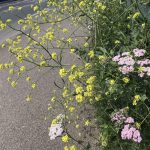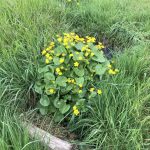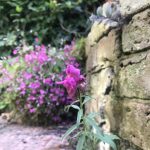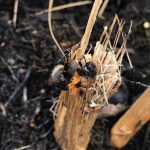The other day I was in the garden watering our fern wall during one of those still and quiet moments that are so rare in central London. Suddenly there was a rustle and I saw to my left a tiny Wren staring back at me from the fence, as surprised to see me as I were it.
It had something green in its beak. Taking a few seconds for me to realise, I saw that this, the minutest of British birds, had caught one of the bright green crickets that I have trouble controlling in our small garden.
Looking into its shiny black eyes with the insect struggling in its beak it struck me how dinosaur this bird was. Birds, the flying ancestors of dinosaurs. Despite the way we dress them up as beautiful, cute or romantic, here a little winged dinosaur had hunted with killer precision within our six metre square city patio. The circle of life goes on.
Attracting wildlife to urban gardens is limited by things you can’t control, our gardens are islands in a sea of concrete. It’s a challenge for wildlife to cross those oceans to find your island. You also can’t control what your many neighbours do in their gardens. Don’t worry about this, you can only control what you can control.
Creating a micro nature reserve in your urban garden or on your balcony or windowsill is pretty simple and adds a new dynamism to your living space.
My four top tips for creating a wildlife friendly urban garden
1) Maximise plant surface area
If you want a wildlife friendly habitat, you need as much habitat as you can grow. I know there is much focus on bug houses which no doubt work but, you know, bugs managed to get by without human built houses before. They do need places to hibernate over winter however, and you can create this with plant life. It is a case of growing as much plant as possible within your outdoor space. Density of plant helps too, so things like Ferns and Grasses really help, especially if evergreen in winter – though make room for flowers too. Grow small plants low down, shrubs to add volume above ground, lots of climbers up walls and fences, and especially try to grow a tree. Read on…
2) Grow a tree
Check very carefully that any tree’s final size is suitable for your size of garden. This RHS guide on small trees is a great place to start. My tip would be to find one that is ‘fastigiate’ which means it grows very upright, so it will remain narrow but tall. If I could do only one thing to encourage wildlife, it would be to try and fit in a tallish flowering tree (e.g. cherry, crab apple etc) into any garden as this will bring birds in, hopefully to nest, if not simply to perch and hunt. Flowering is important to attract more insects. Overall a small tree can add more plant surface area for wildlife than almost anything on the ground. Your garden or balcony may be small, but there is loads of air above it waiting to be filled with plants.
3) Don’t use insecticides
Pretty obvious – if you want wildlife, don’t kill it. Definitely do not use insecticides on flowering plants when insects and bees are particularly attracted to them – I don’t use them at all. If you don’t use insecticides, you’ll find the damage in a garden is minimal and over time the garden balances out. You need problem insects to attract the good wildlife to hunt them. Our only real insect problem to date (excluding slugs and snails where I use organic pellets and nematodes) is aphids, but tolerating these in spring means vast numbers of aphid eating hover fly, lady birds and small birds. I use no insecticides, I just squash the worst aphid infestations, and we have more good insects as a result.
4) Seasonal insect friendly flowers
I aim for successional planting for my own benefit, which is when something is in flower in every season of the year to keep the garden looking good for me to enjoy. Wildlife gardens don’t have to be wild, messy and weedy, they can be highly ornamental. The bonus is that this creates food sources for bees and other insects throughout the year, helping see them through the harsh winter especially. I’m not strict about this but I do try to grow more ‘single’ flowers than ‘doubles’. Double flowers have been bred by humans to have more petals, reducing the number of nectar creating glands and making it harder for bees and other insects to get to what nectar remains. Seasonal flowers are pretty easy. Try Snowdrops, Hellebores and Cyclamen for winter and early spring.
And that’s about it. I know it sounds almost too simple, and I can go into much more detail if you ask me about what does and doesn’t work, but these four fundamentals are all you need to get started. Maximum plant, grow a tree, no insecticides and provide flowers for food.
Oh, just a note on cats. Cats are much maligned by non-cat owners but honestly, they do not cause wanton mayhem for wildlife. We’re lucky that our cat is a useless hunter. That said, our garden is a crossing point for many cats. Yet we still have birds. Because remember, birds are small winged dinosaurs. They live up high and nest up high. If you have a problem with cats and want more birds, grow more tall trees and shrubs – don’t put out plant feeders that attract them down to within easy reach of cats.




Lovely post that – if you ever felt like writing one on bee-friendly cutting gardens I’d be very grateful! I want to dip a toe in the flower-growing pond…
I am very fond of our allotment cat, he is a very good hunter and focuses on 4-legged prey, not two. (I wish he’d eat fewer of our pigmy shrews though, they are very cute!)
Ooh, good idea – I will do that soon. I have some good ideas already as lots of plants I’ve grown are wildlife friendly and good for cutting.